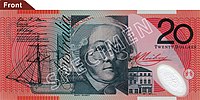Australian twenty-dollar note
| (Australia) | |
|---|---|
| Value | 20 Australian dollars |
| Width | 144 mm |
| Height | 65 mm |
| Security features | Window, Watermark |
| Paper type | Polymer |
| Years of printing | 1994–1998, 2002–2003, 2005–2008, 2010, 2013 |
| Obverse | |
 |
|
| Design | Mary Reibey |
| Designer | Garry Emery |
| Design date | 31 October 1994 |
| Reverse | |
 |
|
| Design | John Flynn |
| Designer | Garry Emery |
| Design date | 31 October 1994 |
The Australian twenty-dollar banknote was issued when the currency was changed from the Australian pound to the Australian dollar on 14 February 1966. It replaced the £10 note which had similar orange colouration. There have been only two different issues of this denomination: a paper note which had a gradient of yellow and red, with a distinct orange background, and a polymer note which can be recognised for its distinct red-orange colouration. The polymer note was issued on 31 October 1994.
As of June 2016[update], 160 million $20 banknotes were in circulation, 11% of the total notes in circulation; worth $3,196 million, or 5% of the total value for all denominations.
Since the start of issuance there have been 14 signature combinations, of which the 1967 issue is of the greatest value, issued for one year only; and the 1989 Phillip/Fraser being issued for less than a year.
From 1966 to 1974 the main title identifying the country was Commonwealth of Australia, there were 146,960,000 notes issued in its life. This was subsequently changed to Australia until the end of the issuance of paper currency for this denomination in 1994 with 1,661,970,048 of these notes being issued.
The people depicted on the paper note issue were Sir Charles Kingsford Smith on the obverse along with five Lissajous curves drawn by a two-pendulum harmonograph, and Lawrence Hargrave on the reverse with his drawings of kites and type aircraft designs.
The polymer note features Mary Reibey on the obverse with an early colonial building and sailing ship including her signature. John Flynn is on the reverse with features of the Royal Flying Doctor Service of Australia of a De Havilland DH.50 biplane Victory supplied by Qantas, medical instruments, Coledge Harland (the man on the camel), who was a missionary to the inland people of Australia. His signature is included. A compass is in the clear window with the raised 20 lettering. These famous people are depicted against a definite red background. The note was designed by Garry Emery.
...
Wikipedia
